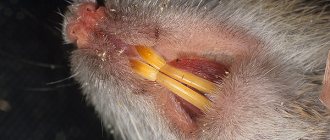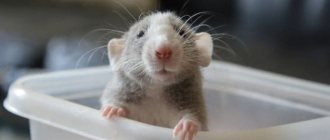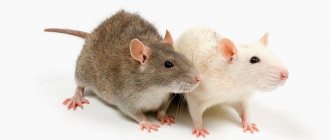Getting a new pet is always exciting, especially when you get a pet rat. One of the most important things to know is what your rodent can and cannot eat. This is important knowledge because feeding your pets the right food is essential to keeping them strong, happy and healthy.
How many times a day do pet rats eat?
These animals eat about 10% of their body weight every day. If you give your pet dry food, your rat should receive 12-20 grams of dry formula per day.
You can also offer your caged rat a few healthy fruits or vegetables every day. If you provide your pet with plenty of fresh foods that contain carbohydrates and protein, you can reduce the amount of formula you feed your pet.
A good way to figure out how much food your rat needs is to offer him 17g of food. At the end of the day, you can check the cage to see how much food the animal has eaten. If there is a lot of food left, you can reduce the amount offered to 12 g. If there is nothing left, you should increase the amount offered.
You can also check on your rat to make sure it is getting enough food. If your rat starts to look chubby, you may want to cut back a bit. If your rat looks too thin, you can give him more treats.
What is the best food for rats?
Pet store rat food is generally the best option for first-time rat owners. Once you know the details of your pet rat's nutritional needs, you can create your own diet if desired.
When shopping for pet rat food, it is important to look for a formula made with high-quality ingredients. Remember that pet rats need a diet with a balanced content of proteins, fats and carbohydrates. Make sure the formula doesn't contain too much fat or calories, and make sure it has enough protein.
Here are some of the best options for commercial rat food:
- Oxbow Essentials Regal Rat Food
– This balanced rat food is formulated for adult rats. It provides a rich blend of nutrients without going overboard with fat to help your pet rat maintain a healthy body weight. - Mazuri Mouse & Rat Food
- Designed for all life stages, this balanced rat food is formulated with high-quality ingredients including omega-3 fatty acids to support your pet's healthy skin and coat. - Vitakraft Complete Nutrition Natural Foraging Blend
– If you are looking for a nutritious way to add variety to your rat's diet, this food blend is a great choice. It consists of nutritionally balanced granules mixed with seeds and vegetables.
Choose your pet rat food wisely because it will be the main source of nutrition. Follow the feeding recommendations on the package to ensure your rat is getting the right amount of food each day.
Peculiarities of nutrition of little rat pups
For the first month after birth, little rat pups feed on their mother’s milk, which after a while is replaced by the food that these animals are accustomed to. The participation of the breeder in the process is practically not required, since the female rodent instinctively knows how to raise babies.
If there are too many offspring, the rat does not have time to look after them all. Then the weakest and most helpless are eliminated through natural selection. For someone who knows what little rat pups eat, it will not be difficult to raise them.
At first, the main food for rat cubs is milk and its derivatives, which are high in vitamins, fats, and beneficial minerals. The best option is dog milk, which, in its absence, can be replaced with goat milk. In addition, small rat pups can be fed with special mixtures.
Important: the transition to artificial nutrition must be carried out smoothly, strictly following the attached instructions, which will prevent oversaturation. Before using the mixture, the water-alkaline balance in babies is restored by taking appropriate medications (for example, Regidron).
- For the first 14 days, feeding is carried out around the clock with a break of 2-3 hours. For 10 gr. weight, the baby needs 0.5 ml of the mixture, which must be prepared before each meal.
- Grown-up rat pups are fed less frequently - every 4 hours, adding low-fat cottage cheese and a little cereal flour to the mixture.
- From the 4th week, rodents can be switched to adult food, but this must be done gradually, without overloading the body.
The scheme for introducing food familiar to rats into the diet of babies is as follows:
- allow the cub to smell and lick new food. You can use a slice of fruit, a boiled egg or a steamed (boiled) vegetable.
- Replace one meal completely with the indicated products, after finely chopping them.
- The next step is to include grains in your diet.
- By the end of the first month of life, the mixture should be completely abandoned, replacing it with other products. However, the baby should be given fermented milk products once a day.
Please note: after taking the mixture, the baby must be given specialized medications to avoid intestinal disorders.
What can you feed pet rats: basic diet
Rats have specific dietary preferences and should be able to choose their own food. Maintaining a healthy but varied diet will prolong the life of your tailed friend.
- Buy special food for rats.
This finished product provides the rat with all the necessary useful and nutritional components. It is specially formulated for kitty rats to provide them with a varied and nutritious diet. - Provide your rat with protein.
In pet stores you can buy food containing meat components that fill the animal's protein needs. Of course, rats can eat anything, but pure meat should not be part of their diet. Protein is especially important for pregnant, newborn and young rodents. The main signs that an animal does not have enough protein are hair loss and infections. - Feed your animal fruits and vegetables.
Pesticides found in some pet foods have negative effects on rats. A harmful substance can disrupt the functionality of the thyroid gland, reduce the number of antibodies and lead to complications in the endocrine system. To prevent such consequences, give your pet as much natural food as possible. Before feeding a fruit or vegetable to your animal, wash the product with soapy water and remove the peel. - Give your rodent treats.
You can express your love for your pet by feeding him his favorite treats. Do this with a variety of pet store snacks and refrigerator foods that your pet enjoys. However, do not give your rat too much fatty food, salt and sugar. This can cause obesity and other ailments in the animal. - Always provide your pet with fresh water.
The cage should always have a full water bowl to prevent the rat from becoming dehydrated. The water needs to be changed every day. Also check the water bowl regularly to make sure it is not clogged. Tap it a couple of times to check that water flows freely through the tube.
Origin
The white rat is an albino form of the gray domestic rat (pasyuk). White albino rats began to be bred at the beginning of the last century in laboratories for scientific experiments. This line of albino laboratory rats gave rise to many other laboratory rat lines (not just albino ones). It is believed that the first ornamental tame rats were obtained from this line by crossing with gray rats. From the white rat, animals were obtained that were black, brown, cinnamon, cream, sepia, silver, and blue.
White lab rats have been bred to have different characteristics: some have special behaviors, such as eating rats that dance; others are distinguished by their coat - long-haired, with a crest (capuchins) and curly hair.
Currently, rats are bred in large numbers in special nurseries and used for various scientific experiments. White rats have a similar genome to humans - the same set of 46 chromosomes. Therefore, white rats are widely used for research in genetics, microbiology, virology, toxicology, and radiobiology.
The results of experiments that scientists share with the general public indicate the extraordinary mental abilities of white rats. White rats are able to sympathize and empathize with other individuals; there are known cases of altruism among white rats.
Can rats eat dairy products?
Although rats love cheese and dairy products, it is important to control their intake. The idea of rats eating cheese seems logical; however, it is extremely important to limit the amount and type of cheese your rat consumes. Cheese is extremely high in fat, so it should be limited or only used as a treat for rats. It's also important to know that not all cheeses are created equally.
Please do not purchase any cheese from the store. When choosing cheese for your rat, make sure it is made only from goat's or cow's milk.
What vegetables and fruits do domestic rats like?
Fruits and vegetables that rats especially love:
- Apples:
Not only is this product safe, but it also offers rats a simple, hassle-free diet. All you need to do is simply cut the apple and serve it to your rat. Make sure you remove all seeds and pits. Apple seeds are dangerous and can cause simple indigestion or respiratory failure in rats. - Avocado:
Although avocado is not recommended for many animals, it is reported to be safe for rats. The seeds may be exposed to some unfavorable conditions, but the rest of the pulp is absolutely safe food for rats. Avocados are rich in fat, so they should be fed in moderation. - Bananas:
When you serve your rat a crushed banana, he will love it and will surely appreciate the gesture. You can add nuts to make the dish tastier. - Blueberries
: This fruit is generally not recommended for pets, but is completely safe for rats. Your rat may get dirty while eating this fruit, so be careful or you'll have to spend extra effort cleaning up all that mess. - Grapes:
This product is a healthy and tasty treat for your rat. You can feed grapes without worrying about health problems. Grapes are known to play an anti-cancer role in rats. - Green Beans
: These are very healthy and will help give your rat a very nutritious diet. - Peaches
: This is also a good option, but be sure to remove the pits from the fruit. Only the pulp portion is safe, while the seeds and pits may pose some health risks to your rat. - Pumpkins
: The pulp of this vegetable is good for rats. But the seeds in this fruit are rich in fats, so they should be given in moderation. - Strawberries
: Strawberries won't be a healthy food, but they make a great treat for your pet. Offering strawberries will strengthen your bond with your rat while also offering him a healthy and nutritious diet.
Along with the above rat-safe foods, you can also feed your rat apricots, blackberries, broccoli, carrots, cashews, cauliflower, cherries, cranberries, cucumber, cabbage, kiwi, mealworms, melons, oatmeal, papaya, parsley, pears, plums, potatoes, raspberries, rice and much more.
Description
Rats have an oval body shape and a stocky build, characteristic of most rodents. The body length of an adult rat ranges from 8 to 30 cm (depending on the species), the weight of the rat varies from 37 g to 420 g (individual gray rats can weigh up to 500 grams).
The rat's muzzle is elongated and pointed, its eyes and ears are small. The tail of most species is practically naked, covered with sparse hairs and ring scales. The black rat's tail is covered with thick fur. The length of the tail of most species is equal to the size of the body or even exceeds it (but there are also short-tailed rats).
The rodent's jaws contain 2 pairs of elongated incisors. Rat molars grow in dense rows and are designed for grinding food. Between the incisors and molars there is a diastema - an area of the jaw where teeth do not grow. Despite the fact that rats are omnivores, they are distinguished from predators by the absence of fangs. Animals' incisors need constant grinding, otherwise the rat simply will not be able to close its mouth. This feature is due to the absence of roots and the continuous growth of the incisors throughout the life of the animal. The front of the incisors are covered with hard enamel, but there is no enamel layer at the back, so the surface of the incisors is ground unevenly and takes on a characteristic shape reminiscent of a chisel. The teeth of rats are extremely strong and can easily gnaw through brick, concrete, hard metals and alloys, although they were originally intended by nature to eat plant foods.
Rats have poorly developed calluses on their paws, which are necessary for rodents to climb, but the functional deficiency is compensated by mobile fingers. Therefore, rats are capable of leading not only a terrestrial, but also a semi-arboreal lifestyle, climbing trees and making nests in abandoned hollows.
Rats are very active and resilient animals, they run well: in case of danger, the animal reaches speeds of up to 10 km/h, overcoming obstacles up to 1 meter high. A rat's daily exercise ranges from 8 to 17 km.
Rats swim and dive well, catch fish and can continuously stay in water for more than 3 days without harm to their health. Rats' vision is poor and has a small viewing angle (only 16 degrees), which forces the animals to constantly turn their heads. Rodents perceive the world around them in shades of gray, and the color red represents complete darkness for them.
Hearing and smell function well: rats perceive sounds with a frequency of up to 40 kHz (for comparison: humans up to 20 kHz), and detect odors at short distances. But rats tolerate the effects of radiation very well (up to 300 roentgens/hour).
The lifespan of a rat in the wild depends on the species: gray rats live about 1.5 years, rare specimens can live up to 3 years, black rats live no more than a year. In laboratory conditions, the life of a rodent increases by 2 times. According to the Guinness Book of Records, the oldest rat was 7 years and 8 months old at the time of death.
Favorite treats for pet rats
Some foods are best given to a rat every now and then - they are equivalent to human "junk food". Dairy products can cause stomach upset, but rats love cheese, so they can be consumed in small quantities from time to time. Rats also love chocolate.
Although chocolate is toxic to dogs, it is not toxic to rats, but it is still not very healthy. Rats can develop cavities in their back teeth, so avoid sugary foods. Boiled eggs, sardines and oysters can be served for dinner, but don't overdo it.
Peanut butter is another favorite, but rats can choke on it if they try to eat too much. Try spreading it on bread so it's not thick and sticky.
Also suitable as treats are sheets of dried seaweed from the Asian section of the supermarket. Large chicken bones are great for rats - they spend a lot of time gnawing on them.
Anything juicy and green will impress your rat - try adding fresh mint leaves to their food or just giving them as treats throughout the day.
Best treat for rats: avocado. Avocados are great for fattening sick rats. Crush it and put it on your dinner as a treat.










